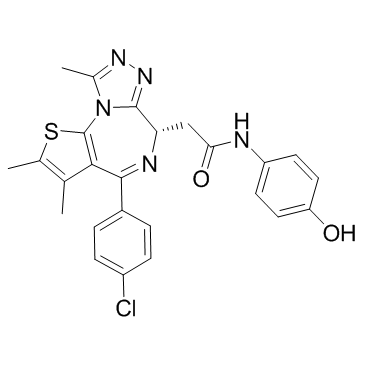202590-98-5
| Name | 6H-Thieno[3,2-f][1,2,4]triazolo[4,3-a][1,4]diazepine-6-acetamide, 4-(4-chlorophenyl)-N-(4-hydroxyphenyl)-2,3,9-trimethyl-, (6S)- |
|---|---|
| Synonyms |
2-[(6S)-4-(4-Chlorophenyl)-2,3,9-trimethyl-6H-thieno[3,2-f][1,2,4]triazolo[4,3-a][1,4]diazepin-6-yl]-N-(4-hydroxyphenyl)acetamide
6H-Thieno[3,2-f][1,2,4]triazolo[4,3-a][1,4]diazepine-6-acetamide, 4-(4-chlorophenyl)-N-(4-hydroxyphenyl)-2,3,9-trimethyl-, (6S)- OTX015 X40LKS49S3 MK-8628 birabresib OTX-015 |
| Description | Birabresib (OTX-015) is a potent bromodomain (BRD2/3/4) inhibitor with IC50s ranging from 92 to 112 nM. |
|---|---|
| Related Catalog | |
| Target |
IC50: 92-112 nM (BRD2, BRD3, BRD4)[1] |
| In Vitro | Birabresib (OTX-015) (500 nM) exposure induces a strong decrease of BRD2, BRD4 and c-MYC and increase of HEXIM1 proteins, while BRD3 expression is unchanged. c-MYC, BRD2, BRD3, BRD4 and HEXIM1 mRNA levels do correlate however with viability following exposure to Birabresib (OTX-015). Sequential combinations of Birabresib (OTX-015) with other epigenetic modifying drugs, panobinostat and azacitidine have a synergic effect on growth of the KASUMI cell line[2]. Birabresib (OTX-015) (0.1, 1, 5 μM) treatment induces HIV-1 full-length transcripts and viral outgrowth in resting CD4+ T cells from infected individuals receiving suppressive antiretroviral therapy (ART), while exerting minimal toxicity and effects on T cell activation. Birabresib-mediated activation of HIV-1 involves an increase in CDK9 occupancy and RNAP II C-terminal domain (CTD) phosphorylation[3]. |
| In Vivo | In MDA-MB-231 murine xenografts, tumor mass is significantly (p < 0.05) reduced by Birabresib (OTX-015) (50 mg/kg) with respect to vehicle-treated animals. Birabresib (OTX-015) in combination with 2 mg/kg everolimus shows more effective activity than Birabresib alone[4]. |
| Cell Assay | For the MTT assay, cells are seeded in 24-well plates at 1×106 per well and treated with Birabresib (OTX-015) (0.01 nM-10 μM) for 72 h. Cells are transferred to 96-well plates and incubated with 0.5 mg/mL 3-(4,5-dimethylthiazol-2-yl)-2,5-diphenyltetrazolium bromide (MTT) in the dark at 37°C for 4 h. Cells are then lysed with 25% sodium dodecyl sulfate (SDS) lysis buffer and absorbance is read at 570 nm using a Microplate Reader. Three independent experiments are run for each cell line and untreated cells are used as negative controls. |
| Animal Admin | Mice are subcutaneously injected in the right flank with 10×106 MDA-MB-231 cells. When average tumor weight is appr 130 mg, mice are randomized (nine animals/group) to one of the following experimental groups: vehicle (for Birabresib (OTX-015), water, twice daily, oral; for everolimus vehicle, 5% Tween-80/5% polyethylene glycol 400, thrice weekly, intraperitoneal); 50 mg/kg Birabresib (OTX-015), twice daily, oral; 2 mg/kg everolimus, thrice weekly, intraperitoneal; 50 mg/kg Birabresib (OTX-015) + 2 mg/kg everolimus, according to the single agent dosing schedules. In the experiment with paclitaxel, mice are randomized (eight animals/group) to vehicle (cremophor:ethanol 1:1, then diluted 1:5 with saline; once weekly, intravenous) or 0.15 mg/kg paclitaxel, once weekly, intravenous. Mice are sacrified at the first sign of severe distress and tumors are collected. Tumor weight (1 mm3 = 1 mg) is determined using the formula d2 × D/2, where 'd' and 'D' are the minor and major diameters of the tumor in mm, respectively. Growth curves of each tumor are normalized with respect to volume at the start of treatment. The doubling time (Td) of each untreated tumor is calculated by exponential fit of the whole growth curve. Treatment efficacy is evaluated based on T/C%, absolute growth delay (AGD) and log cell kill (LCK) parameters. In T/C%, T and C are the mean tumor weight of treated and control groups, respectively. |
| References |
| Density | 1.45±0.1 g/cm3 |
|---|---|
| Molecular Formula | C25H22ClN5O2S |
| Molecular Weight | 491.992 |
| Exact Mass | 491.118286 |
| PSA | 120.64000 |
| LogP | 3.42 |
| Appearance | powder,white to light brown |
| Index of Refraction | 1.730 |
| Storage condition | 2-8°C |
| Water Solubility | Practically insoluble (0.015 g/L) (25 ºC) |
